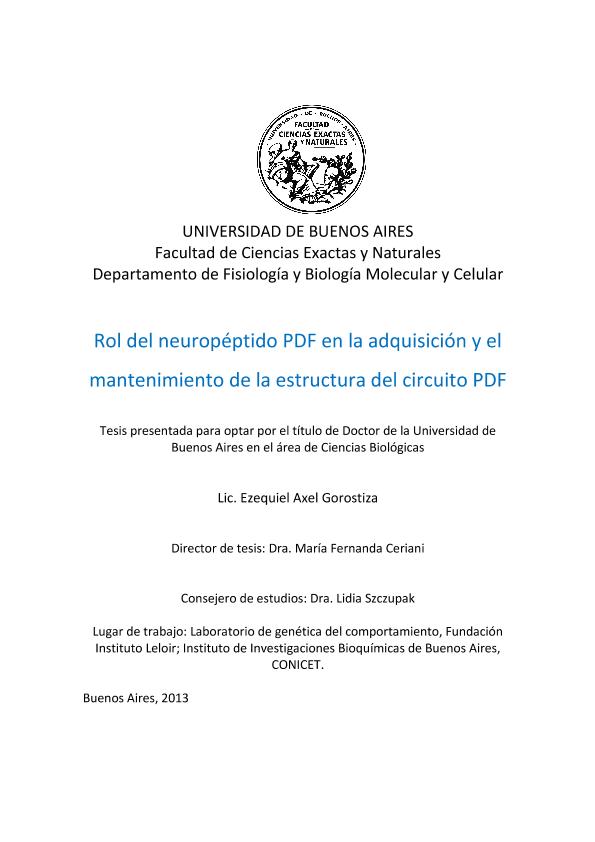Mostrar el registro sencillo del ítem
dc.contributor
Ceriani, Maria Fernanda

dc.contributor.author
Gorostiza, Ezequiel Axel

dc.date.available
2022-01-18T18:34:41Z
dc.date.issued
2013-06
dc.identifier.citation
Gorostiza, Ezequiel Axel; Ceriani, Maria Fernanda; Rol del neuropéptido PDF en la adquisición y el mantenimiento de la estructura del circuito PDF; 6-2013
dc.identifier.uri
http://hdl.handle.net/11336/150262
dc.description.abstract
La ritmicidad comportamental en Drosophila es sostenida por una red neuronal que en el cerebro adulto comprende alrededor de 150 neuronas. Entre éstas, las sLNv han demostrado ser esenciales para el control de la actividad rítmica. Desde el punto de vista circadiano, las sLNv tienen dos características sobresalientes: expresan el neuropéptido PDF, y atraviesan cambios estructurales circadianos en sus terminales axonales, proceso denominado plasticidad estructural. En esta tesis estudiamos qué otros cambios ocurrían concomitantes con la plasticidad estructural. Encontramos que ésta es acompañada por aumentos en el número de sinapsis y disponibilidad de vesículas en momentos de mayor complejidad del árbol axonal, que luego caen durante la fase de menor complejidad. Además demostramos que la plasticidad estructural depende de los niveles de PDF y a raíz de este análisis descubrimos un nuevo rol para PDF durante el desarrollo de las sLNv. La arquitectura adulta de las sLNv necesita que PDF actúe sobre su postsinapsis temprano en el desarrollo larval, proceso que requiere su receptor canónico. Sin embargo, la ausencia de PDF produce defectos presinápticos evidentes luego de la metamorfosis. Comprobamos que previo a la metamorfosis la postsinapsis libera GBB, quien actúa como señal retrógrada sobre las sLNv y promueve el correcto desarrollo del circuito. La ausencia de cualquier componente de la vía de GBB genera defectos semejantes o peores a la ausencia de la vía de PDF. De esta manera revelamos un nuevo mecanismo que provee un marcado temprano de blancos sinápticos que guiarán más tarde en el desarrollo el refinamiento neuronal presináptico.
dc.description.abstract
Rhythmic locomotor activity in Drosophila is sustained by a neuronal network in the adult brain comprised of around 150 neurons. Among them, the sLNvs are considered essential for behavioral rhythmicity. The sLNv have two distinctive characteristics, they express PDF and their axonal arborization changes its shape in a circadian fashion, in a process called structural plasticity. In this thesis we decided to characterize in more depth this remodeling process and assess whether it is accompanied by other changes. We found that a higher structural complexity coexist with a higher number of synapses and releasable vesicles. On the other hand, at times of less complex axonal arborization the number of synapses and releasable vesicles decrease. We also found that the structural plasticity depends on PDF levels. Surprisingly, as we were evaluating this dependence we uncovered a new role for PDF in sLNv development. We showed that mature sLNv circuits require PDF signaling during early development, acting through its cognate receptor PDFR at postsynaptic targets. Yet, axonal defects by PDF knockdown are presynaptic and become apparent only after metamorphosis. At the end of larval stage postsynapses release GBB, which acts as a retrograde signal through its canonic pathway in the sLNv. Downregulation of GBB signaling components restricted to sLNv give rise to morphological defects sometime worse than the observed in pdf01. Thus, we have uncovered a novel mechanism that provides an early “tagging” of future synaptic targets that will guide circuit refinement later in development.
dc.format
application/pdf
dc.language.iso
spa
dc.rights
info:eu-repo/semantics/openAccess
dc.rights.uri
https://creativecommons.org/licenses/by-nc-sa/2.5/ar/
dc.subject
DROSOPHILA
dc.subject
PLASTICIDAD ESTRUCTURAL
dc.subject
CAMBIOS SINÁPTICOS
dc.subject
PIGMENT DISPERSING FACTOR
dc.subject
GLASS BOTTOM BOAT
dc.subject
DESARROLLO DE CIRCUITOS
dc.subject
REFINAMIENTO DE CIRCUITOS
dc.subject
MARCADO DE BLANCOS SINÁPTICOS
dc.subject
METAMORFOSIS
dc.subject.classification
Biología

dc.subject.classification
Ciencias Biológicas

dc.subject.classification
CIENCIAS NATURALES Y EXACTAS

dc.subject.classification
Biología del Desarrollo

dc.subject.classification
Ciencias Biológicas

dc.subject.classification
CIENCIAS NATURALES Y EXACTAS

dc.subject.classification
Neurociencias

dc.subject.classification
Medicina Básica

dc.subject.classification
CIENCIAS MÉDICAS Y DE LA SALUD

dc.title
Rol del neuropéptido PDF en la adquisición y el mantenimiento de la estructura del circuito PDF
dc.title
Role of the PDF neuropeptide in the acquisition and maintenance of the PDF circuit structure
dc.type
info:eu-repo/semantics/doctoralThesis
dc.type
info:eu-repo/semantics/publishedVersion
dc.date.updated
2020-04-22T14:15:15Z
dc.description.fil
Fil: Gorostiza, Ezequiel Axel. Consejo Nacional de Investigaciones Científicas y Técnicas. Oficina de Coordinación Administrativa Parque Centenario. Instituto de Investigaciones Bioquímicas de Buenos Aires. Fundación Instituto Leloir. Instituto de Investigaciones Bioquímicas de Buenos Aires; Argentina. Consejo Nacional de Investigaciones Científicas y Técnicas. Centro Científico Tecnológico Conicet - Córdoba. Instituto de Farmacología Experimental de Córdoba. Universidad Nacional de Córdoba. Facultad de Ciencias Químicas. Instituto de Farmacología Experimental de Córdoba; Argentina
dc.relation.alternativeid
info:eu-repo/semantics/altIdentifier/url/https://bibliotecadigital.exactas.uba.ar/collection/tesis/document/tesis_n5382_Gorostiza
dc.conicet.grado
Universitario de posgrado/doctorado

dc.conicet.titulo
Doctor en Ciencias Biológicas
dc.conicet.rol
Autor

dc.conicet.rol
Director

dc.conicet.otorgante
Universidad de Buenos Aires. Facultad de Ciencias Exactas y Naturales. Departamento de Fisiología y Biología Molecular y Celular
Archivos asociados
